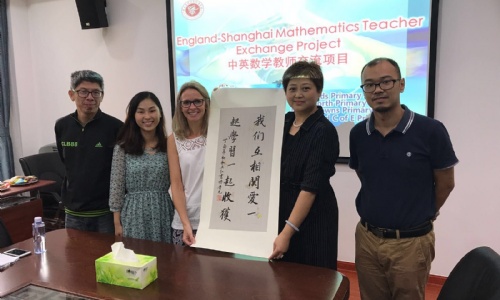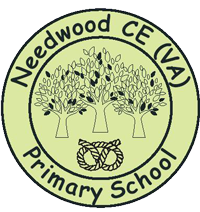Shanghai Exchange

England Shanghai Teacher Exchange (Donna Preston and Susan Brooks)
It was a privilege to visit Shanghai recently and spend time in two schools, the School Affiliated to Jinyuan Senior High School and Shanghai Pudong New Area Yuqiao Primary School.
Our first day included a welcome ceremony at Shanghai Normal University where we heard guest speakers Mr Gao Jianhua, Vice President of Shanghai Normal University, Mr Nabil Ali, Head of the Curriculum Implementation Unit for the Department of Education, Mr Jia Wei, Deputy Director of Shanghai Municipal Education Commission and Mr Li Hai, Deputy Director for the Department of International Cooperation and Exchanges for the Ministry of Education.
We were thrilled to attend a lecture by the Chinese mathematics educationalist, Professor Gu, whose work on variation theory deepened our understanding of this, one of the five big ideas related to mastery.
We also met with our exchange teachers at the event and made plans for the two weeks we would be spending in their schools.
The school visits were made more valuable by us having had our mastery training beforehand. We knew what we were looking out for and were able to question and think more deeply about the structures of the mathematics being taught. It was really evident how much they use variation theory in their teaching to assist the children in learning in small steps, ensuring they all learn together. One example of this was in a grade 4 (year 5) mathematics lesson on comparing fractions. The teacher began the lesson by telling the children a story which involved comparing fractions. The children folded paper circles of the same size to create fractions of ½, ¼ and 1/8.
Comparisons were made by overlaying the circles to find out which fraction was larger/smaller than another. This drew out the conclusion that ‘‘When the numerator is 1, the larger the denominator, the smaller the fraction.’ The teacher regularly got the children to repeat key full sentences about the learning. The children were then asked to compare ¼ and 2/4 using their circles of paper. Again the children were required to answer in sentences and stated ‘There is one quarter in ¼ and there are two quarters in 2/4.’ This learning was then linked to stating how many ninths in 8/9 and then 3/9 and 5/9. There was time given for the children to discuss and feedback to the teacher, again answering in full sentences. This drew out the concept of how to compare fractions when the denominator is the same. As conclusions were made throughout the lesson, the teacher always wrote them on the board. There was then a slide for children to do some practice (see below).
The questions asked were as follows:
‘What are nine lots of 1/12?’
What are 6 lots of 1/7?
How many ¼ make ¾?
How many 1/11 make 5/11?
How many 1/12 make 4/12?
What fraction is multiplied by 14 to make 14/20?
What is 10 lots of 1/10? This was specifically put in to address 10/10 = 1. This concept was then used to solve the next three questions:
How many thirds make 1 whole one?
How many tenths make 1 whole one?
How many thousandths make 1 whole one?
What struck us the most was the carefully chosen link between each question (procedural variation), which helped to reveal the structure of the mathematics.
This led to some further practice work below.
Again the questions have been carefully crafted to allow the children to think mathematically about what is the same and what is different between each question. In each row of questions the teacher supported the children to think through the first one, the children told the teacher what they thought about the second one and the children did the third one alone and then explained it to their partner. This slide is a super example of procedural variation and the discussion and learning that the children gained from it was evident. The top line of questions was using what they had just learned, whereas the bottom row was building upon that to raise the question about the size of a fraction when the numerators are the same but the denominators are different. The 3/8 and ¾ was linked to 1/8 and ¼ initially to support children’s understanding. They then realised that because they know ¼ is bigger than 1/8, then ¾ will be greater than 3/8. The children responded to the inequality sentences by showing the symbols with two fingers, either < or >.
The final part of the lesson involved two real life problems. The first one asked ‘ if a boy drinks 3/8 of his water and a girl drinks 3/7 of her water, who drinks the most?’ One child was quick to respond and say that the boy and girl may not have the same cup size so it may be difficult to solve. The teacher then gave more information, informing the children the cup sizes were the same. The children initially found it hard to compare so the teacher put the image below on the board to support them.
The image helped the children to relate to the fractional quantities and therefore compare them.
A further problem was presented which was ‘Two boys were in KFC drinking coca cola. The first boy left 2/5 of his drink, the other left 2/3 of his drink. Who drank the most?’. One child responded by saying that whoever had the least amount left, had drunk the most. The children talked in their pairs and had to explain their thinking to each other. A girl then explained to the class how you could draw a picture to represent the problem and the teacher then showed them her prepared representation. (below).
The conclusions drawn throughout the lesson were shared again before the lesson ended. The lesson epitomised the depth of understanding that we saw in all the lessons we observed during our time in schools.
Teachers of maths in Shanghai tend to only teach the one subject, though one of our teachers taught computing too. Lessons last thirty-five minutes as they believe that children lose concentration after this point. They have a ten minute break between each lesson. We were also fortunate enough to take part in some of their mathematics meetings (similar to our Teacher Research Groups) in which staff present lessons either before or after teaching them to provide other staff with an analysis about what worked well or not in the lesson or for others to provide support and suggest ideas for lesson planning. This was a valuable time for staff to learn from each other and share good practice.
In addition to all the mathematics we saw, we were treated to examples of the Chinese culture by the children in school, observing lessons in traditional dance and craft and learning about their daily routines such as early morning exercise and brain gym before each lesson. The photographs below give a flavour of what we experienced.
Morning exercise.
Traditional dancing.
Wood shaving craft class.
The whole experience deepened our own understanding of mastery practice and has enabled us to use what we have learned not only in our own classrooms, but to support staff other staff from our own and other schools to progress further with the teaching of mastery in mathematics. The use of small steps is at the core of the approach and the examples we saw have given us further skills and knowledge in order to implement a similar approach. We are very much looking forward to the return visit in January, when local schools will be able to observe lessons. The Chinese were incredibly hospitable and we hope they have a similar experience when they come to England.
Please enter some content for your news story here.
